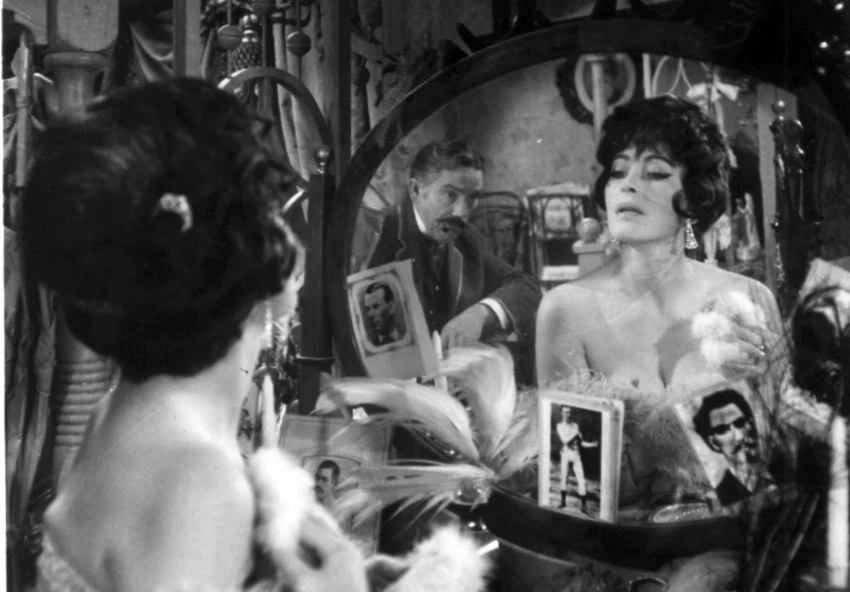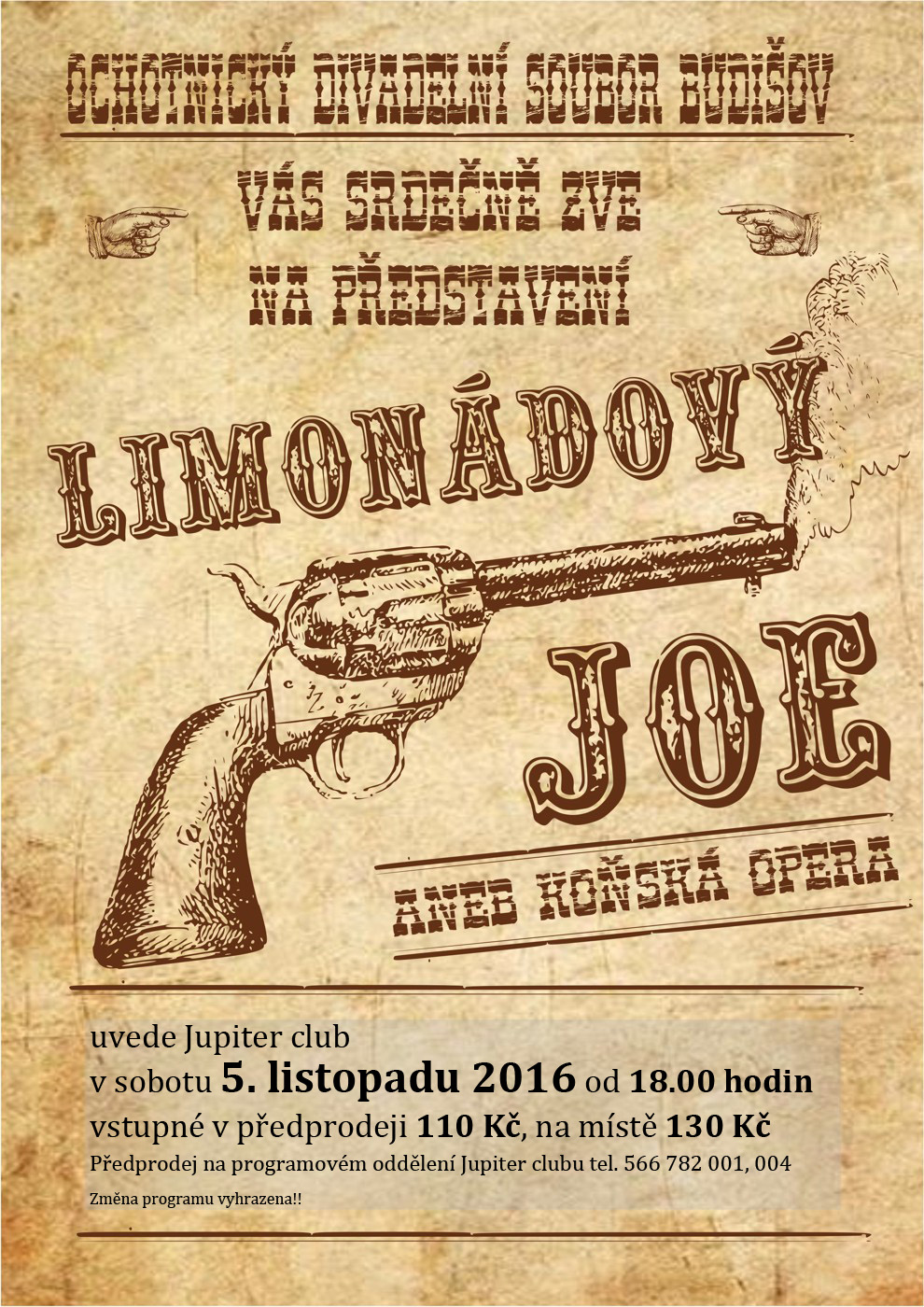An outrageous parody of classic Hollywood westerns, this musical comedy from Czech director Oldrich Lipsky draws on his previous work in animation to spoof and exaggerate the genre. Set in Stetson City, the story opens with a brawl in the Trigger Whisky Saloon. Silver-clad Lemonade Joe rides into town, bringing law and order-and lemonade-to the frontier, while rescuing Winifred Goodman from the clutches of Hogo Fogo. Throughout the film, characters burst into song at the slightest provocation, regaling audiences with such memorable tunes as "Do You See My Moist Lips?" and "When The Smoke Thickens in the Bar." One of the most novel films from the Czech New Wave, LEMONADE JOE is a comic gem and a clever homage to early Hollywood westerns.
- https://www.filmaffinity.com/en/film704452.html

Once, when I was very young, my father used to bring home films to show on his 9mm projector. Alongside Steamboat Willie and Anna May Wong, there was an unnamed western. What amazed me about it was the scene in which both the hero and his horse disappeared behind a small tree (the hero peeped out again but the horse apparently vanished into thin air). There was also an extraordinary bar scene where one punch would down about five villains simultaneously. This all came back to me while watching the new video release of Oldřich Lipský's Czech western Limonádovy Joe aneb koňská opera (Lemonade Joe, or to give the full title, Lemonade Joe or a Horse Opera). Made in 1964, it reminds us that the central and east European nationalised industries did not only produce "socialist" propaganda or films for the festival market.
Of course, a peculiarly central European fascination with the American West has been long standing. The novels of German writer Karl May were a key influence and in the 1970s, in Czechoslovakia, Harald Reinl's 1960s West German films about Winnetou and Old Shatterhand (adapted from May and featuring stars like Stewart Granger, Lex Barker, and Pierre Brice) were very popular. The Czechs themselves also made a couple of adaptations of Jack London stories.
Limonádovy Joe is an attractively naïve musical parody whose references are really to the tradition of western stars like William S Hart and Tom Mix through to singing cowboys like Gene Autry (the yodelling references make that clear). The screenplay was written by Jiří Brdečka, who wrote his Lemonade Joe stories for magazines in the early 1940s, and subsequently adapted them into a stage play in 1946. It is a tribute to an era of innocence before directors like Anthony Mann, Sergio Leone and Sam Peckinpah turned westerns into something altogether more disturbing.
Soft drinks vs the hard liquor
Set in the town of Stetson City, it charts the triumph of good over evil as the protagonists fight over the right to promote whisky or lemonade and compete for the hand of the delectable Winifred Goodman. The film begins with a brawl in the Trigger Whisky Saloon (owned by Doug Badman). Dressed like a member of the Salvation Army and representing the Arizona Revival, Winifred and her father enter the saloon and campaign against the demon drink. In the meantime, the brutish Old Pistol has been getting legless and Doug Badman is shown reading about the legendary exploits of Hogo Fogo: Master Criminal of the Wild West.Roughly at this juncture, Lemonade Joe appears at the swing doors dressed in white from head to toe. Apart from demanding lemonade ("Kolaloka"), he reveals himself to be a superb marksman, dispensing with a fly and Old Pistol's trouser belt with consummate ease. Joe is nothing if not simpleminded, but is still able to foil a bank raid with his casual under the arm shooting. He incidentally hides behind a water butt and gets his white horse (and Winifred) to lie there with him.
Having dispensed justice and converted the townspeople to lemonade, Joe quits town, threatening to return with the law. But the town is soon faced with a new arrival, wearing a black cape and hat, with the sinister appearance of a refugee from Victorian melodrama. This is the legendary Hogo Fogo (in reality, Horace Badman, brother of Joe), who soon turns the town back to its whisky-drinking, card playing ways and has less than honourable intentions toward the virginal Winifred.
Joe returns to rescue Winifred as Hogo Fogo pursues her round her mother's grave, but this is by no means the last of their confrontations. Hogo Fogo is also a magician and a master of disguise, appearing in black face playing a trumpet, as a blind old piano tuner and a family doctor. Besides his battle with Hogo Fogo, Joe is also distracted by the charms of the brunette bar singer, Tornado Lou. He is captured, humiliated and apparently killed but, due to the restorative powers of Kolaloka, returns to kill off his rival.
At this point, he discovers that he is related to Doug, Hogo Fogo and Tornado Lou—they are brothers and sister, orphans who have been raised separately. Kolaloka ensures that they are all brought back to life and the ending is presided over by Joe's father, president of the Kolaloka company. Joe and Winifred go off on the next stagecoach and, in true capitalist fashion, a new company and a new drink are created: Whiskykola, which can be drunk by both teetotallers and alcoholics.
Tributes to Ford and parallels with Leone
If all this sounds like a cartoon, it is not surprising, as Brdečka was a leading writer and director of animated films and had scripted Jiří Trnka's earlier puppet Western parody Arie Prérie (Song of the Prairie, 1949), as well as Trnka's first postwar film Pérák a SS (Springer vs the SS, 1946). The film contains quite a few ideas from animated films: smoke rings providing secret clues in a card game, dotted lines to represent Joe's bullets, frozen shots as he appears at both ground and roof level, an image of the threatened Winifred reproduced in the sky. There's even a scene in which he passes a sign advertising the Acme Tool Company.The long sequence in which Hogo Fogo (as blind piano tuner) sings about his life to Winifred, is accompanied by a montage of dime magazine illustrations and the sinister turning of his superimposed head in many disguises. We are not far from the Feuillade serial (Hogo Fogo even has false arms in one scene) and the Arizona connection provides a fairly explicit link to the early silent Arizona Bill—and perhaps even the Arizona Jim of Renoir's Monsieur Lange.
There are also apparent Fordian tributes: Winifred by her mother's grave, Doug Badman balancing his feet on the hitching rail like Henry Fonda's Wyatt Earp. Tornado Lou has many precedents of which Dietrich's Frenchy (Destry Rides Again) is just one. Interestingly, given the fact that the film was made the same year that Leone directed A Fistful of Dollars, there are even extreme close ups that seem like a parody of Leone's style. But the wide screen close up down Joe's throat as he practices his characteristic yodelling is quite without parallel, past or present.
The golden voice of Prague
The cast is headed by Karel Fiala, a star of operetta, as Joe. Miloš Kopecký, fresh from his role as Zeman's Baron Prášil (Baron Műnchhausen, 1961), plays the villain with suitably theatrical menace, while Olga Schoberová plays Winifred. Schoberová also appeared in the West German westerns Gold-diggers of Arkansas and Black Eagles of Santa Fe, both of which were filmed in Czechoslovakia. She was later to appear in the Lipský/Brdečka feature Adéla ještě nevečeřela (Adela Hasn't Had Supper Yet aka Nick Carter in Prague, 1977), as well as in Juraj Jakubisko's banned Slovak film Dovidenia v pekle, priatelia! (See You in Hell Fellows!,1969, completed 1990). Under the more pronounceable name of Olinka Berová, she appeared in Hammer Films' The Vengeance of She (1968) and became a Playboy covergirl.Besides being a comedy, the film is also a musical with key songs for most of the characters: Tornado Lou (When the Smoke Thickens in the Bar; Do You See My Moist Lips?), Winifred (Arizona, Where All Good Men Come From), Joe (Oh, ye gods, what a dime drink!)—but, perhaps, best of all, Hogo Fogo's life story. The film begins with honky tonk piano but soon finds an excuse for plenty of traditional style jazz and popular Czech singers. The voice of Joe is provided by Karel Gott, "The Golden Voice of Prague," and there's even a song for Waldemar Matuška (in the small role of the Coyote Kid).
Worth it just for the title
The director, Oldřich Lipský, who died in 1986, was a specialist in comedies, and worked with a number of leading Czech comic writers, including Miloš Macourek (Zabil jsem Einsteina, pánové/Gentlemen, I Have Killed Einstein, 1969) and Zdeněk Svěrák, author of Kolya (1996), Jáchyme, hoď ho do stroje (Joachim, Put it in the Machine, 1974) and Marečku podejte mi pero (Mareček, Pass Me a Pen, 1976). He also worked with Brdečka on Adéla ještě nevečeřela and Tajemství hradu v Karpatech (A Mystery Castle in the Carpathians, 1981).Despite the originality of many of these scripts and the filmic references inLimonádovy Joe, Lipský was a rather orthodox director. But his is an idiosyncratic vein of comedy, and one hopes that other titles may become available. Adéla ještě nevečeřela, which features a man-eating plant named Adela, created by Jan Švankmajer, has already acquired something of a cult following. Its alternative title Nick Carter in Prague refers to the prototype detective hero of US dime magazines, who was immortalised in the French silent series of 1908.
I'd also like to put in a plea for two other 1960s parodies on popular heroes, Superman and 007, both of which were directed by the still active Václav Vorliček: Kdo chce zabít Jessii? (Who Wants to Kill Jessie?,1966), scripted by Macourek and featuring Schoberová as Jessie, and Konec agenta W4C prostřednictvím psa pana Foustky (The End of an Agent by means of Mr Foustka's Dog aka End of an Agent,1967). Of course, the titles deserve a prize in themselves, rivalled only perhaps by Jindřich Polák's Zitra vstanu a opařím se čajem (Tomorrow I'll Wake Up and Scald Myself with Tea, 1977).
- Peter Hames www.kinoeye.org/02/15/hames15.php




Nema komentara:
Objavi komentar